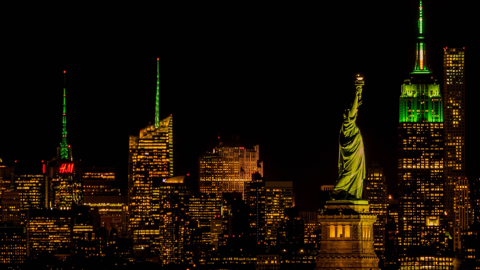
Sep 23, 2024
Although most people care deeply about addressing the climate crisis, only a minority of respondents in recent surveys trust their governments to achieve a fair and just net-zero transition. One promising way to address this disconnect is through citizens’ assemblies, which should happen both nationally and globally.
NEW YORK – It has been nearly ten years since countries came together in Paris and agreed finally to get serious about averting a climate disaster. But while there is an emerging consensus on the structural economic reforms needed to transform sectors such as energy, transportation, and agriculture, the necessary investments are not being made fast enough

China’s Climate Balancing Act
ZONGYUAN ZOE LIU explains how decarbonization and climate security have been integrated into the government’s broader agenda.
Instead, our governance systems are struggling to muster an adequate response to what is an increasingly obvious and severe climate and ecological crisis. Although many governments have proposed robust climate measures, these often trigger a social backlash, because they are perceived as unjust and inequitable. Many see policies that pit the old against the young, the city against the country, or the Global North against the Global South. Such controversies are tailor-made for social media, where they ripen and then rot in a hothouse of misinformation, incendiary rhetoric, and polarization.
Although the argument for the necessity of major reform has been won, the argument for how to do it fairly has not. This challenge will become only more difficult the deeper we get into the net-zero transition. Most people care deeply about addressing the climate crisis: in a survey conducted across 18 G20 countries, 71% of respondents agreed that major action is needed immediately to reduce carbon emissions. But trust in government action is lacking, with only 39% believing that their own government will act effectively.
One way to address this gap is to allow citizens participation in the elaboration and implementation of climate policies and measures designed by governments. Instead of having climate policies imposed by technocrats from above, governments should embrace approaches that combine “top-down” with “bottom-up” methods, with the latter bringing together ordinary people who are tasked with shaping a shared vision of the future.
Successful examples of those participatory methods already exist. Citizens’ assemblies in France are decision-making bodies composed of randomly selected, demographically representative individuals who deliberate on a specific issue of public concern and provide policy recommendations.
In addition to fostering consensus on divisive topics, citizens’ assemblies educate the public about complex policy issues and give citizens a direct role in decisions that affect their lives. These elements are especially important for issues like the net-zero transition, which entails major economic changes that can leave communities feeling divided. Unlike politicians, assembly members make decisions free from electoral pressures and lobbying. Notable examples include Ireland’s assemblies on marriage equality and abortion, which led to national referenda and breakthrough legislation; and France’s climate assembly, which helped shape its most ambitious climate bill to date.
Brazil’s long standing participatory approach to policymaking has also proved successful. For example, its Climate Plan is being developed through a governance structure that includes several ministries of the federal government together with representatives from the scientific community, subnational governments, the private sector, and civil society.
Moreover, a climate participatory platform (involving both digital and in-person exchanges) has been launched to invite all Brazilian citizens to propose solutions. The National Environmental Conference and the National Social and Economic Development Council, by prioritizing the Climate Plan, have further contributed to strengthening this bottom-up process.
Such methods can steer climate policy proposals away from sources of polarization, and toward opportunities for collaboration and deliberation. Among G20 countries, 62% of people favor using citizens’ assemblies for decision-making, and that number has risen above 70% in countries like Brazil, India, Indonesia, Mexico, and South Africa, and to over 80% in Kenya. More than 170 citizens’ assemblies have been held in more than 30 countries, each with the goal of accelerating climate action in ways that support a fair and just transition for all.
Drawing on the model of the World Social Forum, what we need now is a Global Social-Climate Forum, or a Global Citizens’ Assembly for People and Planet, to bring citizens together from every country, not just to chart a collective path forward, but to reimagine our politics and encourage a global ethical stock-take. This would be an opportunity for humanity to come together, to understand each other’s aspirations and anxieties, and to co-create a green transition that benefits everyone. Rather than leaving anyone behind, we can forge a new social contract rooted in solidarity, equity, and fairness.
In 2015, France and Peru established a new mechanism, the Action Agenda, because they recognized that the scale of change needed to tackle the climate crisis requires more than just government action. It also depends on the wealth of ideas that civil society – including businesses, cities, and communities – has to offer.
As countries prepare to announce their next climate commitments in 2025, we must acknowledge the critical role that ordinary citizens have to play, both individually and collectively, in addressing the climate crisis. At COP30 and beyond, we must provide a dedicated space to hear every voice, and to ensure that the transition is not only fast but fair. Failing that, we will not achieve our common goals. That is why Brazil is committed to making COP30 (in November 2025) the People’s COP, and to giving every person on Earth the opportunity to participate in shaping our common future.

PS Events: Climate Week NYC 2024
Watch our Climate Week NYC 2024 event now to hear speakers from across the globe – including Mia Amor Mottley, Prime Minister of Barbados; Gabriel Boric, President of Chile; Jiwoh Abdulai, Minister of Environment and Climate Change of Sierra Leone; and Maisa Rojas Corradi, Minister of the Environment of Chile – discuss climate leadership, development finance, and more.
WATCH NOW

LAURENCE TUBIANA
Writing for PS since 2012
Laurence Tubiana, a former French ambassador to the United Nations Framework Convention on Climate Change, is CEO of the European Climate Foundation and a professor at Sciences Po, Paris.

ANA TONI
Writing for PS since 2021
Ana Toni is National Secretary for Climate Change at the Ministry of Environment and Climate Change of Brazil.








